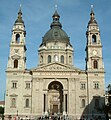Miklós Ybl: Difference between revisions
m →External links: Task 15: language icon template(s) replaced (1×); |
|||
| Line 1: | Line 1: | ||
{{Eastern name order|Ybl Miklós}} |
|||
{{Infobox architect |
{{Infobox architect |
||
| name = Miklós Ybl |
| name = Miklós Ybl |
||
| Line 15: | Line 16: | ||
| children = Félix |
| children = Félix |
||
}} |
}} |
||
| ⚫ | '''Miklós Ybl''' (6 April 1814 in [[Székesfehérvár]] – 22 January 1891 in [[Budapest]]) was one of Europe's leading architects in the mid to late nineteenth century as well as [[Hungary]]'s most influential architect during his career. His most well-known work is the [[Hungarian State Opera House]] in [[Budapest]] (1875–84). |
||
| ⚫ | '''Miklós Ybl''' ( |
||
After graduating from the Institute of Technology (the ''Politechnikum'') in [[Vienna]], Ybl became [[Mihály Pollack]]'s assistant in 1832 and worked in [[Henrik Koch]]'s office between 1836 and 1840. Following this, he moved to [[Munich]] and then to Italy to study. After his return, he entered into partnership with the son of Mihály Pollack, Ágoston; together they refurbished the Ikervár castle of Count [[Lajos Batthyány]]. His first main work was the church in Fót, built between 1845 and 1855. |
After graduating from the Institute of Technology (the ''Politechnikum'') in [[Vienna]], Ybl became [[Mihály Pollack]]'s assistant in 1832 and worked in [[Henrik Koch]]'s office between 1836 and 1840. Following this, he moved to [[Munich]] and then to Italy to study. After his return, he entered into partnership with the son of Mihály Pollack, Ágoston; together they refurbished the Ikervár castle of Count [[Lajos Batthyány]]. His first main work was the church in Fót, built between 1845 and 1855. |
||
Revision as of 09:11, 6 February 2020
Miklós Ybl | |
|---|---|
 Miklós Ybl (1865) | |
| Born | Miklós Ybl 6 April 1814 |
| Died | 22 January 1891 |
| Nationality | Hungarian |
| Alma mater | TU Wien, Vienna Munich Academy, Munich Arts et Métiers ParisTech, Paris |
| Occupation | Architect |
| Spouse | Ida Lafite |
| Children | Félix |
| Practice | Henrik Koch Mihály Pollack |
| Buildings | Budapest Opera House Saint Stephen's Basilica Buda Castle |
Miklós Ybl (6 April 1814 in Székesfehérvár – 22 January 1891 in Budapest) was one of Europe's leading architects in the mid to late nineteenth century as well as Hungary's most influential architect during his career. His most well-known work is the Hungarian State Opera House in Budapest (1875–84).
After graduating from the Institute of Technology (the Politechnikum) in Vienna, Ybl became Mihály Pollack's assistant in 1832 and worked in Henrik Koch's office between 1836 and 1840. Following this, he moved to Munich and then to Italy to study. After his return, he entered into partnership with the son of Mihály Pollack, Ágoston; together they refurbished the Ikervár castle of Count Lajos Batthyány. His first main work was the church in Fót, built between 1845 and 1855.
His early, large projects were built in Romantic style, influenced by eastern motifs. Although Romanesque shapes also occur in his later buildings, after his second study tour to Italy from 1860 he became interested in the possibility of the revitalisation of the Italian Renaissance style, and designed several neo-Renaissance buildings. Many of his buildings became, and indeed are still today, determinant elements of the cityscape of Budapest: Saint Stephen's Basilica (1867–91), the Rác Thermal Bath, the former Palace of Customs, (1871–74), and the throne room and Krisztinaváros wing of the Royal Palace. He also built countless churches, apartments and castles in the provinces.
The annual architectural prize founded in 1953 was named after him in his honor.
Gallery
-
Catholic church in Fót
-
Károlyi Palace, Budapest
-
Ybl designed the Palace of Customs which today houses the Corvinus University of Budapest
-
Ikervár - Palace
Major works

- 1845-1849. Fót, Károlyi castle rebuilding
- 1845-1855. Fót, Roman Catholic church
- cc. 1852. Budapest, Grabovszky – (Rózsa-) villa
- 1857-58. Budapest, National stables
- cc. 1860. Albertirsa, Szapáry chapel crypt
- cc. 1860. Leányfalu, Gyulai-villa
- cc. 1860. Gerla, Wenckheim castle
- 1860-1864. Nagycenk, R.C. church
- from 1862 Kecskemét, Evangelical church
- 1862-1865. Budapest, Festetics palace
- 1863. Budapest, German theatre (not built)
- from 1863. Budapest, Károly palace
- 1863-1864. Budapest, MTA building
- cc. 1865. Fegyvernek, Szapáry castle
- 1865-1866. Budapest, old parliament building
- 1865-1879. Budapest, R.C. church, Bakáts squ.
- 1867. Budapest, Pálffy palace
- 1867-1891. Budapest, Szent István basilica. Began by Hild, continued by Ybl and finished by J. Kauser
- 1870-1874. Budapest, Customs house
- 1871. Budapest, Margit bridge (not built)
- cc. 1872. Parád, Ybl Hotel
- 1873-1884. Budapest, Hungarian State Opera House
- 1874-1982. Budapest, Castle kiosk and bazaar
- 1875-1879. Ókígyós, Wenckheim castle
- 1880-1882. Parádsasvár, Károlyi castle
- 1880-1891. Budapest, Castle hill remodelling
- 1882-1888. Budapest, Budapest Clarisseum R.C. church
- 1883-1884. Budapest, Széchenyi palace (demolished)
- cc. 1888. Parád, Erzsébet Hotel
- and other structures in Csurgó, Doboz, Kétegyháza, Lengyeltóti, Mácsa, Marcali, Ókigyós, Surány, etc.
See also
External links
![]() Media related to Miklós Ybl at Wikimedia Commons
Media related to Miklós Ybl at Wikimedia Commons





